Hello there, lovely reader! I’m Julie, an education professional passionate about Montessori education. Today, I want to delve into a topic that’s garnering a lot of buzz in the education and parenting circles – the Montessori floor bed. Let’s jump right into it!
The Concept of a Montessori Floor Bed
I’m sure you’re wondering what exactly I mean by a Montessori floor bed. Well, it’s pretty straightforward. The idea behind it is to allow children access to their bed, affording them flexibility and promoting their independence. The bed is literally a mattress placed on the floor without the constraints of a traditional frame or crib.
The Benefits it Offers
When I first introduced my toddler to a Montessori floor bed, I wasn’t sure what to expect. But the benefits were outstanding. It promotes independence and freedom of movement. Children learn to understand their sleep cues and take ownership of their sleep habits. It’s all about encouraging autonomy!
One of the most remarkable benefits of the Montessori floor bed is how it nurtures a child’s developing sense of independence. This bedding arrangement allows toddlers to not only decide when to sleep and when to wake but also to engage with their room and belongings on their own terms. This empowerment extends beyond the bedroom, influencing their confidence and self-esteem in various aspects of life.
In addition to fostering autonomy, the floor bed also significantly enhances a child’s physical development. Without the confines of a crib, children have the freedom to move in and out of bed. This freedom encourages physical activities such as crawling, standing, and walking, which are crucial for muscle development and coordination. The open environment of a floor bed makes it easier for children to explore their capabilities and limits in a safe space.
Safety is another critical benefit. The low height of the floor bed minimizes the risk of injuries from falls, which is particularly important for active sleepers or those transitioning from a crib. Parents can further ensure safety by arranging a padded carpet or soft mats around the bed, creating a gentle landing spot that reinforces the safe area for young explorers.
The floor bed also plays a significant role in establishing healthy sleep habits. By providing children with the opportunity to respond to their natural sleep cues, the floor bed helps them regulate their sleep patterns more effectively. This self-regulation not only contributes to better sleep quality but also reduces the bedtime struggles often experienced with traditional cribs. Children who feel they have control over their sleep are more likely to have a positive association with bedtime and, consequently, a healthier relationship with sleep as they grow.
Moreover, the Montessori floor bed can dramatically transform the parent-child dynamic at bedtime. With this setup, parents can lie down with their child at their level, share bedtime stories, and engage in quiet conversations. This not only comforts the child but also strengthens the bond between parent and child, making bedtime a more enjoyable and intimate experience.
By detailing these additional benefits, the concept of the Montessori floor bed is further enriched, highlighting its holistic impact on a child’s development and the family’s daily routine.
When to Start Using a Floor Bed
Many people ask me when the right time to transition to a floor bed is. To be frank, there isn’t one “perfect” age. Some parents start as early as 6 months while others wait until their child is a bit older. As with everything else, it depends on your child’s readiness and individual needs.
How to introduce the Floor Bed
Remember, moving to a floor bed is a significant change for your child. Start by introducing the concept during the day. They can play on it or even take naps. As they become more comfortable and familiar with the concept, you can start letting them sleep there at night.
Deciding the appropriate time to introduce a Montessori floor bed can vary significantly from one family to another, influenced by several factors beyond just age. Understanding your child’s developmental milestones can be a helpful guide. For instance, if your child has begun to crawl or pull themselves up to stand, they might be ready for a floor bed. This is because the bed allows them to freely move in and out without the limitations of a crib, aligning with their growing desire for exploration and movement.
Another factor to consider is the child’s sleep patterns. If your child has started to resist the confines of a crib or frequently attempts to climb out, it might be safer and more appropriate to transition to a floor bed. This change can provide them with a sense of freedom while reducing the risk of falls from trying to climb over crib rails.
The layout and safety of your child’s bedroom are also crucial in determining when to switch to a floor bed. Before making the transition, ensure the room is fully childproofed. Secure furniture to the walls, cover electrical outlets, and remove any small or hazardous objects within the child’s reach. Additionally, consider the placement of the bed, ideally away from windows, heaters, and cords, to create a safe sleeping environment.
Parents should also reflect on their readiness and comfort level with this transition. Introducing a floor bed is a commitment to a more independent sleeping arrangement that requires monitoring and possible adjustments to the child’s room. It’s important that parents feel prepared to adapt their approach to bedtime and potentially intervene less as their child learns to manage their sleep independently.
Lastly, listening to your instincts as a parent is invaluable. Every child is unique, and no one knows your child better than you. Observing their behavior, discussing with your pediatrician, and considering your family’s daily routines will help you make a decision that best suits your child’s and your family’s specific needs.
By addressing these varied factors, parents can better gauge the optimal time to introduce a Montessori floor bed, ensuring it aligns with their child’s developmental stage and the family’s overall readiness for this change.
Montessori beds: different beautiful and original designs
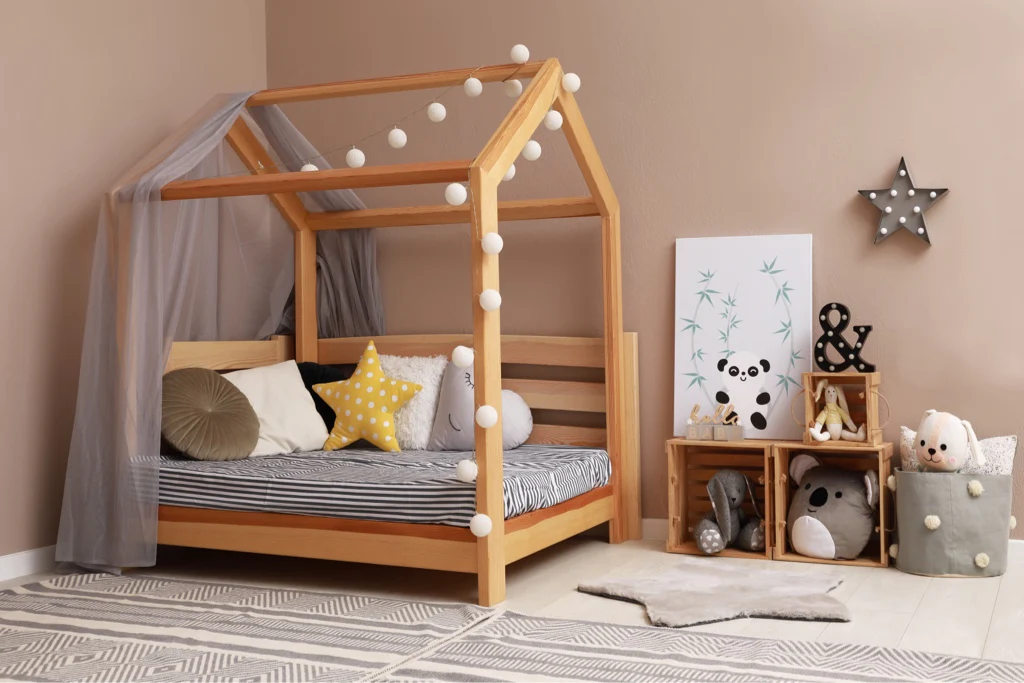
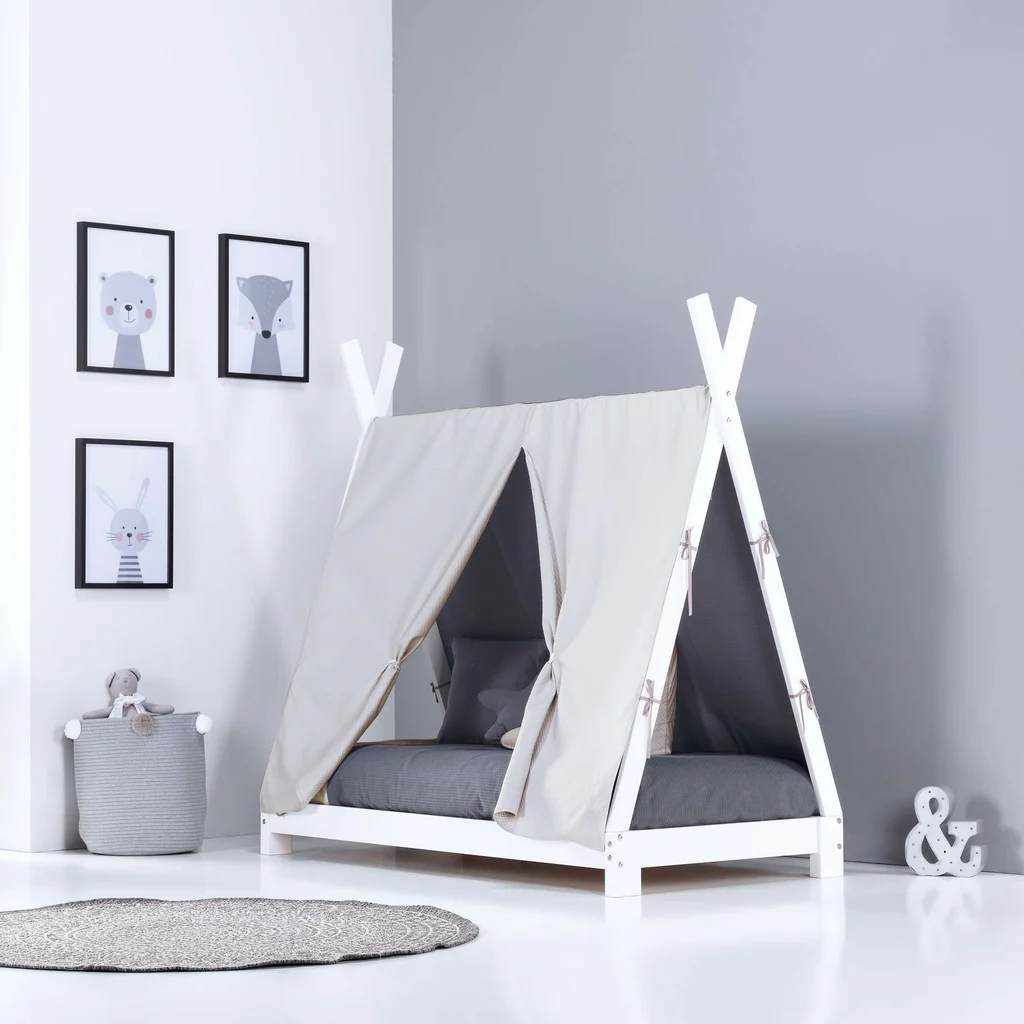
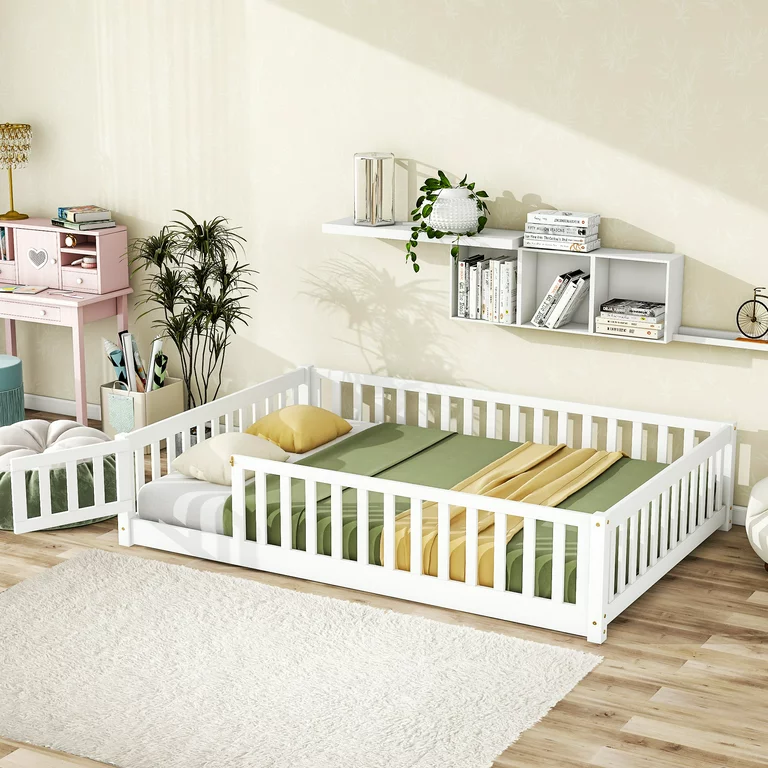
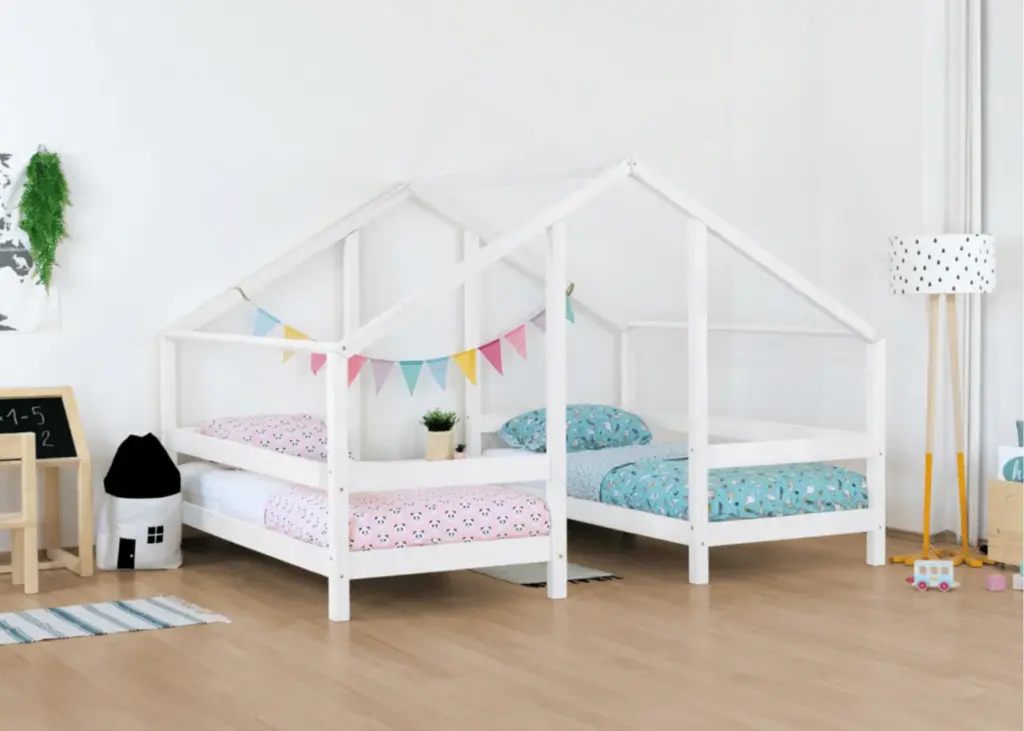
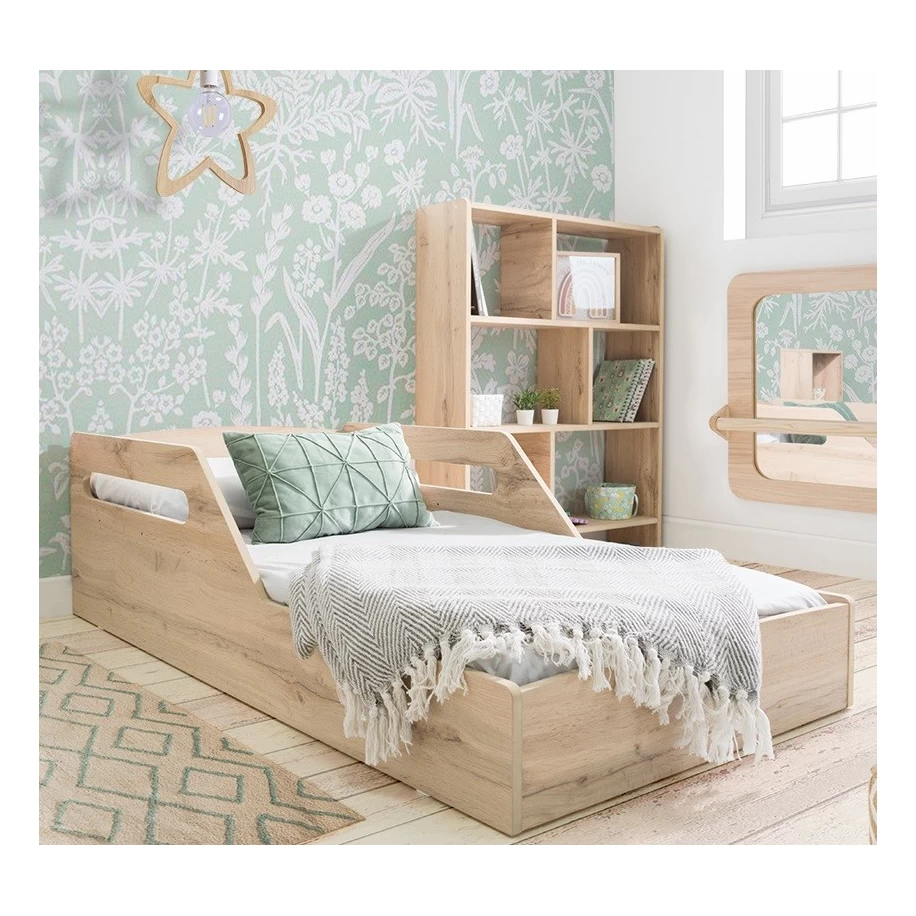
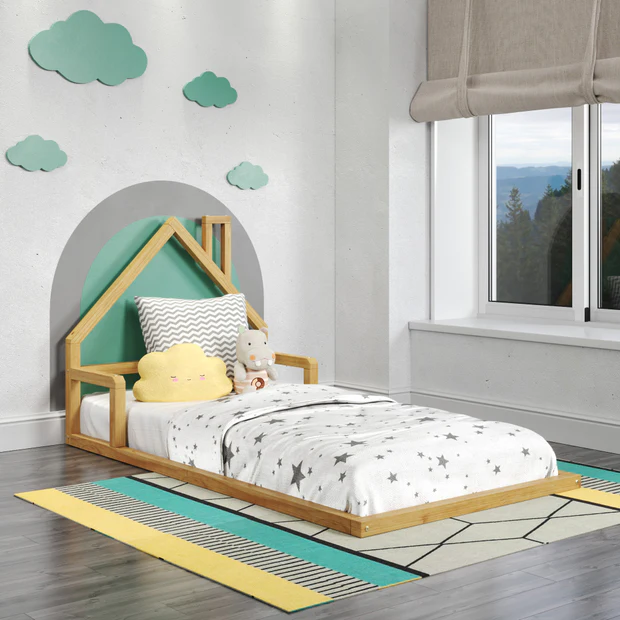
Selecting the Right Montessori Furniture and Toys
Simply having a floor bed is not enough; the rest of the environment should be conducive to a child’s exploration and independence. Low shelves with age-appropriate toys, a child-sized table and chair are fantastic additions. As always, safety is paramount. Make sure all furniture and toys are secure and pose no tipping hazards.
Creating an enriching Montessori environment goes beyond the floor bed to include thoughtful selection of furniture and toys that enhance the child’s learning and growth. When choosing these items, consider their functionality and how they can foster a child’s curiosity and skills development.
1. Consider the Scale and Accessibility: Furniture should be sized for the child to ensure that they can use it without assistance. This includes items like tables, chairs, and storage units. Ensuring that the child can reach all their belongings not only promotes independence but also encourages them to take responsibility for their own space, including tidying up after themselves.
2. Material and Quality: Opt for furniture and toys made from natural materials such as wood, which not only are safer but also provide a sensory experience that is warm and inviting. These materials are generally more durable and safer than plastic, which can break and create sharp edges. Wooden toys and furniture pieces also often fit the aesthetic of a calm and natural Montessori environment.
3. Adaptability and Longevity: Invest in furniture that can grow with your child. Many Montessori furniture pieces are designed to be adjustable; for example, shelves that can change height or a table that can expand. This adaptability makes these purchases more economical over time, as they will remain useful as your child grows.
4. Safety Features: Ensure that all furniture is stable and sturdy to prevent it from tipping over. Secure bookshelves, dressers, and other large pieces to the wall. Check that toys and furniture have non-toxic finishes and do not have small parts that could be choking hazards for younger children.
5. Aesthetic and Functionality: Choose items that are aesthetically pleasing but simple, without overwhelming colors or patterns. This helps maintain a calm and focused environment conducive to learning. Each piece of furniture should serve a clear purpose and contribute to the child’s overall learning and development.
6. Sensory and Developmental Toys: Select toys that align with Montessori principles of self-directed learning. These might include puzzles, building blocks, art supplies, and practical life tools that promote fine motor skills, problem-solving abilities, and creative expression.
By carefully selecting furniture and toys that meet these criteria, you can create a Montessori home environment that not only complements the floor bed setup but also deeply supports your child’s development in becoming a confident, independent learner.
Your Thoughts
There you have it, my lovely readers. I’d love to hear your thoughts on this topic. Do you use a Montessori floor bed? How has the transition been for your child? Feel free to share your experiences and tips. If you have any questions, drop them in the comment section. I’d love to help!
Until next time, happy parenting!


Leave a Reply